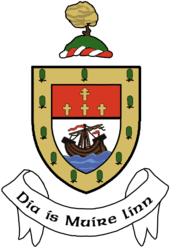Inishglora
| Native name: <span class="nickname" ">Inis Gluaire | |
|---|---|
 A freshwater well on Inishglora | |
 Inishglora | |
| Geography | |
| Location | Atlantic Ocean |
| Coordinates | 54°12′36″N 10°07′41″W / 54.210°N 10.128°WCoordinates: 54°12′36″N 10°07′41″W / 54.210°N 10.128°W |
| Highest elevation | 22 m (72 ft) |
| Administration | |
| Province | Connacht |
| County | Mayo |
Inishglora (Irish: Inis Gluaire) is an island off the coast of the Mullet Peninsula in Erris, County Mayo in Ireland. It has some small neighbouring islands, known as Inishkeeragh. The island has been uninhabited since the early 20th century, but there are several ecclesiastical ruins on the island.
Geology
Inishglora is geologically similar to the neighbouring Inishkea Islands, and is composed of gneiss and schist, similar to the rest of Erris. The island is mainly covered with machair and white sand. The Inishkeas and Inishglora differ markedly geologically from Duvillaun which lies a short distance to their south. From the mainland, the first two islands shine white and green in the sunlight while Duvillaun (and its satellite islands) lives up to its name and appears a much duller colour with dark cliffs because it has the same geology as Achill, many miles to its south.
History
Inishglora is probably the best known of the islands off Erris as it is considered to be the holiest of all the islands. It lies north of the islands of Duvillaun and the two islands of the Inishkeas .

There are several archaeological remains on the island. The ruins of Saint Brendan's Church indicate that the original building was similar in style of Gallarus Oratory in County Kerry. There are the remains of two other churches also - Teampall na bhFear (Men's Church) and Teampall na mBan (Women's Church). The women's church may have been an early nunnery. Both are now ruins but date back just a few centuries and are more modern than Saint Brendan's Church. There are the remains of three beehive huts, the largest of which is known as Saint Brendan's cell. There are many superstitions about the religious relics on Inishglora. There is a well, known as Saint Brendan's Well. The superstition says that if a woman were to take water from it, the water would turn to blood and become full of worms. However, these rumours may have been invented to ensure that nuns and monks would not use the well as an illicit meeting place.[1] Inishglora also has several early cross slabs and pillars.
Legend and writings
Legend relates that the Children of Lir flew to Inishglora at the end of their 900-year banishment to remote spots across Ireland. The children had been turned into swans by their jealous stepmother because their father loved them too much, in her eyes. On Inishglora, they were baptised by Saint Brendan the Navigator, and regained their former human shapes but, because they were now 900 years of age, they immediately crumbled into dust. They were then reputedly buried on the island.
Geraldus Cambrensis writing in 1186AD in Topographia Hibernica said of Inishglora:-
- "There is an island called Aren (When Giraldus called Inishglore, Aren, he had confused it) situated in the western part of Connaught and consecrated, as it is said to St. Brendan, where human corpses are neither buried nor decay, but, deposited in the open air, remain uncorrupted. Here men can behold and recognise with wonder their grandfathers, great grandfathers and great great grandfathers and the long series of the ancestors to a remote period of past time"[2]
The Book of Ballymote notes that bodies on Inishglora do not corrupt, and this poem by Roderic O'Flaherty Ruaidhrí Ó Flaithbheartaigh used Ogygia as a synonym for Ireland in 'Ogygia: Seu Rerum Hibernicarum Chronologia' ("Ogygia: A Chronological Account of Irish Events"), 1685 seems to be of the same opinion.
- At Inisglóire in view of lrrus shore,
- Should we the bodies of our sires explore,
- We'd find them blooming, both nails and hair,
- No human-flesh can fade or perish there.
There are no 'uncorrupted' bodies on Inishglora now however, and many bones have been found buried around the island. It is a local belief that after the religious communities left the island, things returned to normal.
Giraldus Cambrensis also wrote of Inishglora Island:
- "There is another remarkable thing in this island. Although mice (possibly black rats) swarm in vast numbers in other parts of Ireland, here not a single one is found. No mouse is bred here, nor does it live if it be introduced; when brought over, it runs immediately away and leaps into the sea. If it be stopped, it instantly dies." [2]
References
- ↑ http://irishislands.info/glora.html
- 1 2 Wright, T. (Ed) The Historical works of Giraldus Cambrensis (1913) London
External links
| Wikimedia Commons has media related to Inishglora. |

